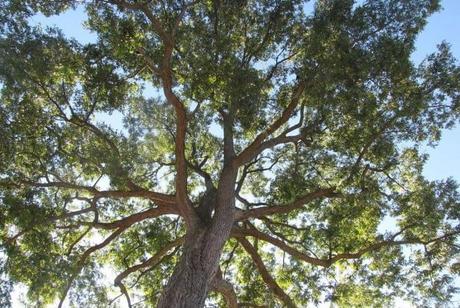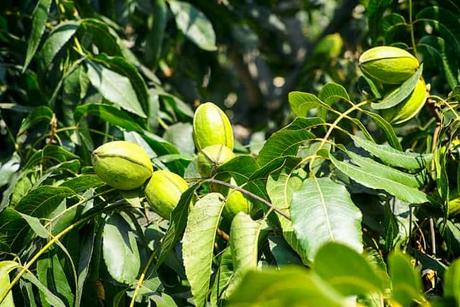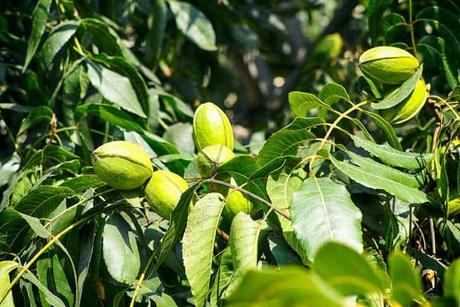If you are a foodie or a health enthusiast, you’ve probably heard of pecan nuts. These delicious nuts can amp up any salad, and they are often used as a garnish for juices as well. But have you ever wondered where these nuts come from? Well, these nuts are produced by the beautiful and lofty Pecan tree, which is a deciduous tree belonging to the family of Juglandaceae.
The Pecan tree comes with a thick, gray brownish trunk with a wide (almost 2 m) diameter and an oval canopy that spreads along. Its bark appears scaly and ridged, and its twigs are reddish-brown. As with other deciduous trees, the Pecan tree has dark greenish foliage where the leaves are beautifully divided featuring elongated leaflets. The leaflets are known for their serrated margin and their curved tips.

The Pecan tree can produce both male and female catkins. While the male produces pollen, the female catkins later develop into fruits. Pecan trees come in multiple varieties and growing them at home is easier than you thought.
In this article, we will offer a short overview of the Pecan tree with guidelines about watering, planting, and harvesting it. So, if you are planning to grow a Pecan tree at home, here’s everything you need to know about.
Variety
Since Pecan trees are not as easy to grow, you need to be extremely patient with them. Most of the species won’t even bear nuts until they reach 6 years. In some cases, it might also take the plant 10 years to successfully bear nuts. While there are multiple species of the Pecan Tree, we will discuss two common species in detail.
The first in our list is the Pawnee. Growing in hardiness zones from 6 to 9, they are smaller when compared to other variants of Pecan trees. Pawnee’s can assume around 30 feet in height. Another common specie of the Pecan tree is Candy. Producing nuts during the summer months, Candies can assume a height of up to 70 feet.
Planting
Growing up to 150 feet in height, Pecan trees require plenty of space for optimal growth. Given their extensive size, you should consider planting them at a distance of at least 30 feet from all major structures like power lines, smaller or bigger trees, and buildings.
Since these trees are not naturally fertile, you will need to cross-pollinate them. While you can always grow one Pecan tree if there’s another one in the vicinity; but if such is not the case, you will need to get at least two trees at proximity so that both can bear edible nuts.
Ideally, you should consider planting this tree in the Spring months. To start the process, first, dig a deep hole of around 4 feet in an area with moist and well-draining soil. In case your garden soil is rocky or shallow, it would not be a good idea to plant the Pecan tree in the first place. Also, note that these plants require full and consistent sun throughout the entire day. So, make sure you plant it in a spot that does not witness any shade.
After zeroing in on the best spot for your tree, dig a small hole with the same depth as a ball. Make sure the hole is wide enough to comfortably accommodate the tree. In case you are planning to get this tree from a nursery, make sure you get it at a height of 4 to 6 feet.
If you are growing the tree in a pot, you will need to focus on the roots even before planting it. Circle the taproot right at the base of the plant, straighten it out, and position your tree vertically. If you find the taproot extremely tangled whereby you can’t straighten it anymore, trim the bottom off and knead the rest of your roots with your fingers so that they can easily spread across in the hole you’ve prepared for them.
If the roots are damaged, make sure you remove them even before planting them. Also, if the roots are extremely dry, consider soaking them in water for a couple of hours right before you plant them.
When you reach a stage where your tree is perfectly ready for being planted, gently place it in the small hole ensuring that the root sits vertically without getting slouched at the lower edge. The soil line should also be on a complete ground level. You might want to stop in the middle to properly water the hole enabling the soil to settle. After this, press it down with your hands to get rid of any excess air holes, before you add the remaining soil. Follow the same process until the hole is filled.
After the Pecan Tree is planted, make sure the top third part is duly removed. This will enable the tree to completely focus on its root system even before it needs to support the height.
Watering
As you probably know at this point, young Pecans require plenty of water to survive. So, if you live in a dry or arid region that doesn’t witness frequent rainfall, consider watering the trees at least once a week. This will keep the soil moist by allowing it to tap into the moisture. Once you reach a stage where the soil can’t take in the water anymore and the water is seen to be running off, stop with the watering schedule.
Usually, young Pecans need around 5 to 20 gallons of water every week. Water itself is the sole determinant of the quality and the quantity of nuts that the tree will produce. Most mature Pecans can tolerate drought thereby surviving without a frequent waterfall.
However, if producing quality pecans is your goal, make sure the soil of the mature trees too is moist from time to time. You can water up to 2 to 3 inches every week during the spring and summer months. This simple watering regime will develop full and mature nuts.
Pecans are known to be thirsty, especially during their youth. That is why it is even more important to team it up with well-draining soil. This will prevent root rot and will also ensure the safety of the plant. You might also want to add sand to the soil for better drainage.
Another excellent option would be mulch which goes a long way in helping your tree to retain water. Mulch is often a top requirement for Pecan tree cultivars as it bars water from quickly evaporating from the ground soil.

Sunlight
One of the biggest requirements for growing Pecan trees is proper and full sunlight. Since these plants also grow and thrive in large, open spaces, finding a sunny spot shouldn’t be as tough. While planting the trees, make sure they are at least 30 feet away from buildings or trees. The bottom line: avoid shade at all costs.
Temperature
Native to Central and Southern parts of the US, this tree is fond of a warm climate. That is why you will primarily find it in parts of Texas, Tennessee, Illinois, Arkansas, and other southern areas. While the plant is now widely cultivated across many regions of the US, make sure the temperature is properly warm for its optimal growth.
In terms of soil, it prefers growing in US hardiness zones 5 to 9. However, although most of these zones are deemed ideal, Pecans growing in some of these parts are known to suffer due to temperature drops during the night-time.
Most Pecan trees will need a proper and consistent dose of warmth both during the day and night. Since the temperature in some zones is known to drop significantly low, it is best to shift them indoors after the evenings, especially during the colder months. Despite this issue, some species of pecans can successfully adapt to low temperatures.
Feeding
As with many other full-grown, fruit-bearing trees, Pecan trees require fertilizer applications. Ideally, you should ensure that your plant receives plenty of nitrogen. That is why it is important to use a fertilizer with high nitrogen content. Consider applying it during the spring months. However, make sure you do not apply the fertilizer right at the trunk of the tree as this area is likely to be impacted by fertilizer burns.
Pecans are also known to be heavily dependent on zinc. Since most of our average soils do not have high zinc content, we recommend you add some amount of zinc sulfate (at least half a pound) for every year of the tree’s age. For instance, a 5-year-old tree would require around 2.5 pounds of zinc every year.
You should also consider testing the pH of your soil even before you get it treated with Zinc sulfate. Usually, acidic soil that has a pH level of less than 6 is likely to respond better to treatment with zinc sulfate. However, the same treatment will be practically useless when done on an alkaline-based soil.
That is because certain compounds of alkaline affect the solubility of zinc, hindering it from dissolving it in the soil. So, if your garden has alkaline soil, consider using a zinc foliar spray. Check the recommended guidelines of the spray before applying it to your soil.
Usually, Pecan trees are harvested between September and November. Depending on your tree’s variety and climate, you will understand the ideal time for harvesting it. One of the easiest ways to find this out is by checking if the pecan is bursting out from the hulls. Once it does, you can be sure that it is indeed ready for harvest.
In some instances, you will notice that the pecans break from their hulls before finally dropping to the floor. If such is the case, get them up as soon as you can, else birds or small insects might peck on them. In case the ground is wet, it might also cause the pecans to rot or turn stale.
When you notice multiple pecans emerging from the hulls, shake or poke their branches in a bid to make them drop. Use a long stick to make things easier. Also, before starting the shaking, keep a clean sheet on the ground so that collecting the nuts is significantly easier. After a round of harvest, you will need to take the time in getting the nuts dried. This can be done by spreading them out on a fairly hard surface in a spot with ample air circulation and fairly low light. It will take a couple of days to a few weeks to cure the nuts properly.
Once the nuts are well cured, you can consume them immediately. Alternatively, you can also refrigerate them for later consumption.
Well, now that you’ve read about the planting, watering, sunlight requirements of the Pecan Tree what are you waiting for? Check your local market, get the required seedlings and fertilizers, and start planting this tree right away!
References
Temperature


